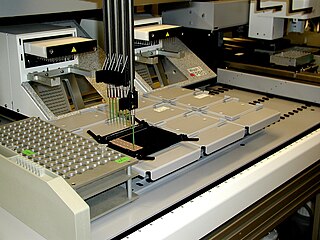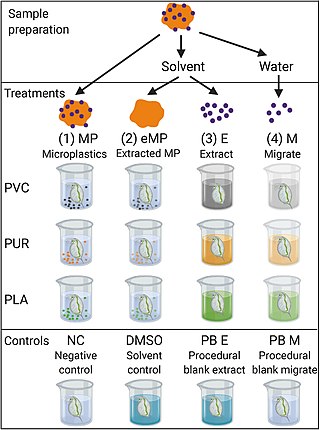Related Research Articles

Analytical chemistry studies and uses instruments and methods to separate, identify, and quantify matter. In practice, separation, identification or quantification may constitute the entire analysis or be combined with another method. Separation isolates analytes. Qualitative analysis identifies analytes, while quantitative analysis determines the numerical amount or concentration.

Proteomics is the large-scale study of proteins. Proteins are vital parts of living organisms, with many functions such as the formation of structural fibers of muscle tissue, enzymatic digestion of food, or synthesis and replication of DNA. In addition, other kinds of proteins include antibodies that protect an organism from infection, and hormones that send important signals throughout the body.
Laser-induced fluorescence (LIF) or laser-stimulated fluorescence (LSF) is a spectroscopic method in which an atom or molecule is excited to a higher energy level by the absorption of laser light followed by spontaneous emission of light. It was first reported by Zare and coworkers in 1968.

Archer John Porter Martin was a British chemist who shared the 1952 Nobel Prize in Chemistry for the invention of partition chromatography with Richard Synge.
Chemical biology is a scientific discipline between the fields of chemistry and biology. The discipline involves the application of chemical techniques, analysis, and often small molecules produced through synthetic chemistry, to the study and manipulation of biological systems. In contrast to biochemistry, which involves the study of the chemistry of biomolecules and regulation of biochemical pathways within and between cells, chemical biology deals with chemistry applied to biology.

Molecular motors are natural (biological) or artificial molecular machines that are the essential agents of movement in living organisms. In general terms, a motor is a device that consumes energy in one form and converts it into motion or mechanical work; for example, many protein-based molecular motors harness the chemical free energy released by the hydrolysis of ATP in order to perform mechanical work. In terms of energetic efficiency, this type of motor can be superior to currently available man-made motors. One important difference between molecular motors and macroscopic motors is that molecular motors operate in the thermal bath, an environment in which the fluctuations due to thermal noise are significant.

Richard Neil Zare is the Marguerite Blake Wilbur Professor in Natural Science and a Professor of Chemistry at Stanford University. Throughout his career, Zare has made a considerable impact in physical chemistry and analytical chemistry, particularly through the development of laser-induced fluorescence (LIF) and the study of chemical reactions at the molecular and nanoscale level. LIF is an extremely sensitive technique with applications ranging from analytical chemistry and molecular biology to astrophysics. One of its applications was the sequencing of the human genome.
Annual Reviews is an independent, non-profit academic publishing company based in San Mateo, California. As of 2021, it publishes 51 journals of review articles and Knowable Magazine, covering the fields of life, biomedical, physical, and social sciences. Review articles are usually “peer-invited” solicited submissions, often planned one to two years in advance, which go through a peer-review process. The organizational structure has three levels: a volunteer board of directors, editorial committees of experts for each journal, and paid employees.
In mass spectrometry, direct analysis in real time (DART) is an ion source that produces electronically or vibronically excited-state species from gases such as helium, argon, or nitrogen that ionize atmospheric molecules or dopant molecules. The ions generated from atmospheric or dopant molecules undergo ion-molecule reactions with the sample molecules to produce analyte ions. Analytes with low ionization energy may be ionized directly. The DART ionization process can produce positive or negative ions depending on the potential applied to the exit electrode.

Protein mass spectrometry refers to the application of mass spectrometry to the study of proteins. Mass spectrometry is an important method for the accurate mass determination and characterization of proteins, and a variety of methods and instrumentations have been developed for its many uses. Its applications include the identification of proteins and their post-translational modifications, the elucidation of protein complexes, their subunits and functional interactions, as well as the global measurement of proteins in proteomics. It can also be used to localize proteins to the various organelles, and determine the interactions between different proteins as well as with membrane lipids.

The Annual Review of Analytical Chemistry is a peer-reviewed academic journal that publishes an annual volume of review articles relevant to analytical chemistry. It was established in 2008 and is published by Annual Reviews. As of 2023, it is being published as open access, under the Subscribe to Open model.

Annual Review of Biochemistry is an annual peer-reviewed scientific journal published by Annual Reviews, a nonprofit scientific publisher. Its first volume was published in 1932, and its founding editor was J. Murray Luck. The current editor is Roger D. Kornberg. The journal focuses on molecular biology and biological chemistry review articles. As of 2023, Journal Citation Reports gives the journal an impact factor of 16.6, ranking it seventh out of 285 journals in the category "Biochemistry and Molecular Biology". As of 2023, it is being published as open access, under the Subscribe to Open model.
Partition chromatography theory and practice was introduced through the work and publications of Archer Martin and Richard Laurence Millington Synge during the 1940s. They would later receive the 1952 Nobel Prize in Chemistry "for their invention of partition chromatography".

Instrumental analysis is a field of analytical chemistry that investigates analytes using scientific instruments.

In the field of cellular biology, single-cell analysis and subcellular analysis is the study of genomics, transcriptomics, proteomics, metabolomics and cell–cell interactions at the single cell level. The concept of single-cell analysis originated in the 1970s. Before the discovery of heterogeneity, single-cell analysis mainly referred to the analysis or manipulation of an individual cell in a bulk population of cells at a particular condition using optical or electronic microscope. To date, due to the heterogeneity seen in both eukaryotic and prokaryotic cell populations, analyzing a single cell makes it possible to discover mechanisms not seen when studying a bulk population of cells. Technologies such as fluorescence-activated cell sorting (FACS) allow the precise isolation of selected single cells from complex samples, while high throughput single cell partitioning technologies, enable the simultaneous molecular analysis of hundreds or thousands of single unsorted cells; this is particularly useful for the analysis of transcriptome variation in genotypically identical cells, allowing the definition of otherwise undetectable cell subtypes. The development of new technologies is increasing our ability to analyze the genome and transcriptome of single cells, as well as to quantify their proteome and metabolome. Mass spectrometry techniques have become important analytical tools for proteomic and metabolomic analysis of single cells. Recent advances have enabled quantifying thousands of protein across hundreds of single cells, and thus make possible new types of analysis. In situ sequencing and fluorescence in situ hybridization (FISH) do not require that cells be isolated and are increasingly being used for analysis of tissues.

Annual Review of Physical Chemistry is a peer-reviewed scientific journal published by Annual Reviews. It covers all topics pertaining to physical chemistry. The editors are Todd J. Martínez and Anne McCoy. As of 2023, Annual Review of Physical Chemistry is being published as open access, under the Subscribe to Open model. The journal is indexed in the Science Citation Index Expanded and Chemical Abstracts Service. As of 2023, Journal Citation Reports gives it a 2022 impact factor of 14.7.
Stephen G. Weber is a professor of chemistry and clinical translational science at the University of Pittsburgh. He researches analytical separations theory and its application, and has developed "green" techniques for molecular recognition and microextractions. He is particularly interested in the identification of peptides and dipeptides, and their effects on neurochemistry. He has received a number of awards, including the 2016 Dal Nogare Award for "contributions to the fundamental understanding of the chromatographic process".

A bioassay is an analytical method to determine the concentration or potency of a substance by its effect on living animals or plants, or on living cells or tissues. A bioassay can be either quantal or quantitative, direct or indirect. If the measured response is binary, the assay is quantal, if not, it is quantitative.

Robert Mark Wightman is an electrochemist and professor emeritus of chemistry at the University of North Carolina at Chapel Hill. He is best known for his work in the areas of ultramicroelectrodes, electrochemistry, and neurochemistry. One of Wightman's most notable achievements is the development of the ultramicroelectrode and microelectrode voltammetry. At the same time as Wightman's innovations, the microelectrode was developed independently by Martin Fleischmann at the University of Southampton. In 2011, Wightman had the 192nd highest h-index, 74, of any living chemist. As of 2018, Wightman was an author of over 390 papers and had an h-index of 103.
Shelley D. Minteer is an American academic and chemistry professor at the University of Utah. Minteer field of study focuses on the interface between biocatalysts and enzyme-based electrodes for biofuel cells and sensors.
References
- 1 2 3 4 "Edward S Yeung". Department of Chemistry. Iowa State University. Retrieved 5 June 2021.
- ↑ Yeung, Edward S.; Zare, Richard N. (13 June 2008). "Preface". Annual Review of Analytical Chemistry. 1 (1). doi:10.1146/annurev.ac.061308.100001 . Retrieved 8 September 2021.
- ↑ "Co-editors of the Annual Review of Analytical Chemistry - Volume 7, 2014". Annual Reviews Directory. Retrieved 8 September 2021.
- ↑ Cannon Jr, D. M.; Winograd, N.; Ewing, A. G. (June 2000). "Quantitative Chemical Analysis of Single Cells". Annual Review of Biophysics and Biomolecular Structure. 29 (1): 239–263. doi:10.1146/annurev.biophys.29.1.239. ISSN 1056-8700. PMID 10940249 . Retrieved 8 September 2021.
- ↑ Hogan, Barry L.; Yeung, Edward S. (January 1993). "Single-cell analysis at the level of a single human erythrocyte". TrAC Trends in Analytical Chemistry. 12 (1): 4–9. doi:10.1016/0165-9936(93)85007-6 . Retrieved 8 September 2021.
- ↑ Lin, Yuqing; Trouillon, Raphaël; Safina, Gulnara; Ewing, Andrew G. (15 June 2011). "Chemical Analysis of Single Cells". Analytical Chemistry. 83 (12): 4369–4392. doi:10.1021/ac2009838. PMC 3115477 . PMID 21500835.
- ↑ Wixom, Robert L.; Gehrke, Charles W. (2010). Chromatography : a science of discovery. Hoboken, N.J.: Wiley. pp. 193–194. ISBN 978-0-470-28345-5 . Retrieved 8 September 2021.